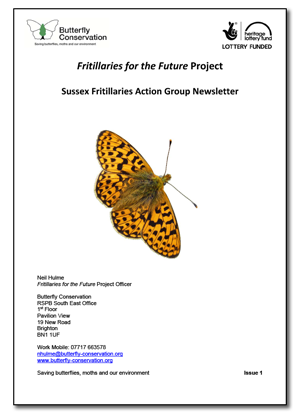Fritillaries for the Future Project

A conservation project has been launched to stop the drastic decline in numbers of two of the rarest woodland butterflies in Sussex - the Pearl-bordered and Small Pearl-bordered Fritillary.
Wildlife charity Butterfly Conservation has set up the three-year project Fritillaries for the Future with funding from the Heritage Lottery Fund, after experts recorded a sustained drop in the number of sightings coming in across the county.
Both species were once common and widespread in the Sussex, but last year no Small Pearl-bordered Fritillaries were seen at the only remaining colony site in the county, raising fears it may have been lost from the South East entirely. New data from the UK Butterfly Monitoring Scheme (UKBMS) has also confirmed that the Pearl-bordered Fritillary has undergone a 72% decline in numbers across the whole country since 1976.
The Fritillaries for the Future project plans to restore a healthy population of these butterflies to extensive parts of the Sussex landscape. It is hoped this can be achieved by improving woodland habitats and re-introducing captive-bred butterflies to suitable areas, including Butterfly Conservation’s Park Corner Heath and Rowland Wood reserves near East Hoathly in East Sussex.
Both of these butterflies look very similar on the upper side of their wings, which are a striking orange-brown colour, overlain with black spots. The underside of the rear wings is intricately patterned, resembling a stained glass window. A subtle difference in the range of yellow, pale orange and deeper reddish brown blocks of colour helps distinguish between the two species, as does the arrangement of numerous silvery-white studs - the butterfly’s ‘pearls’.
The caterpillars of both species feed on violets, which flourish shortly after an area of woodland has been cleared or coppiced. The old, country name for the Pearl-bordered Fritillary was ‘The Woodman’s Friend’, referring to its habit of following the charcoal burners and hurdle makers around the wood, as new clearings were created every year. The historical decline in traditional woodland management practices has led to a greatly reduced amount of suitable habitat.
The Fritillaries for the Future project will provide advice to landowners on how they can best manage areas of woodland for the benefit of these endangered butterflies, in a sustainable and often profitable manner. The active management of woodland helps a wide range of other insects, birds and animals. Beautiful flowering plants such as Bluebell, Bugle, Wood Anemone, Lesser Celandine and Wild Garlic all thrive when sunlight is allowed to reach the woodland floor, bringing renewed health and vibrancy to a wood.
The project will also focus heavily on community engagement, particularly with young people - the future guardians of our natural heritage. There will be outdoor events arranged for primary school children, who will be able to help by growing violet plants to feed hungry captive-bred caterpillars.
Older students will be able to learn more about traditional woodland management practices and the creation of wildlife-friendly habitats. Guided walks, illustrated talks and training in butterfly recording will also be provided.
Project Officer, Neil Hulme, said:
“I have fond childhood memories of family picnics back in the 1970s, when on sunny, spring days we would see the Pearl-bordered or Small Pearl-bordered Fritillary in many of the woods we visited. I took them for granted. They were as much a part of that magical time of year as the Cuckoo or the Nightingale. If we lose these species, we lose part of our spring.
“It is vital that we raise public awareness of the plight of these butterflies, which many people will never have seen. I would encourage those with an interest to get involved. A huge, collective effort is required to save these precious pearls.”
Project Officer Neil Hulme: 07717 663578, or email nhulme@butterfly-conservation.org
Download the "Sussex Fritillaries Action Group Newsletter" here. (2.9MB pdf)
![]()



